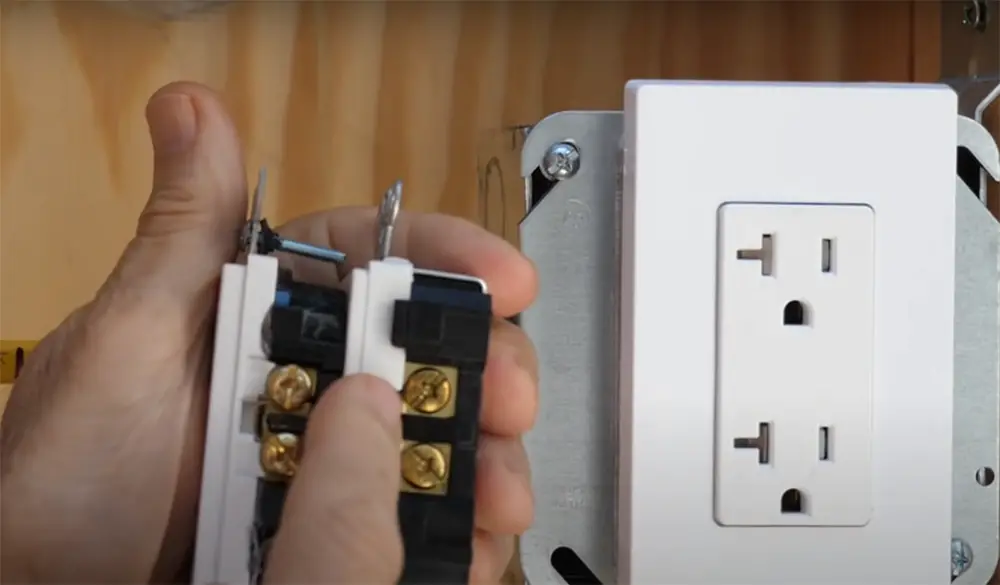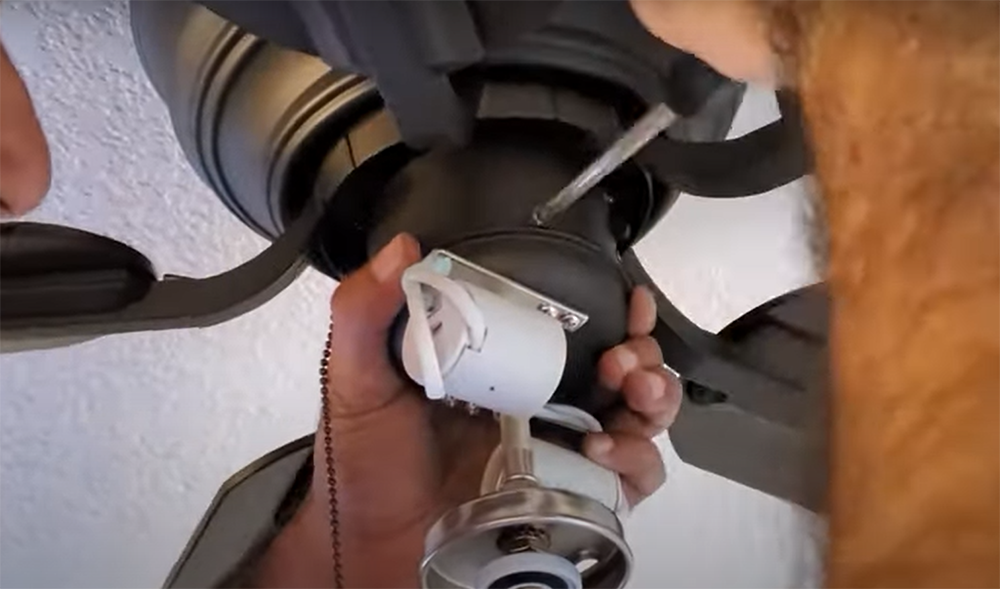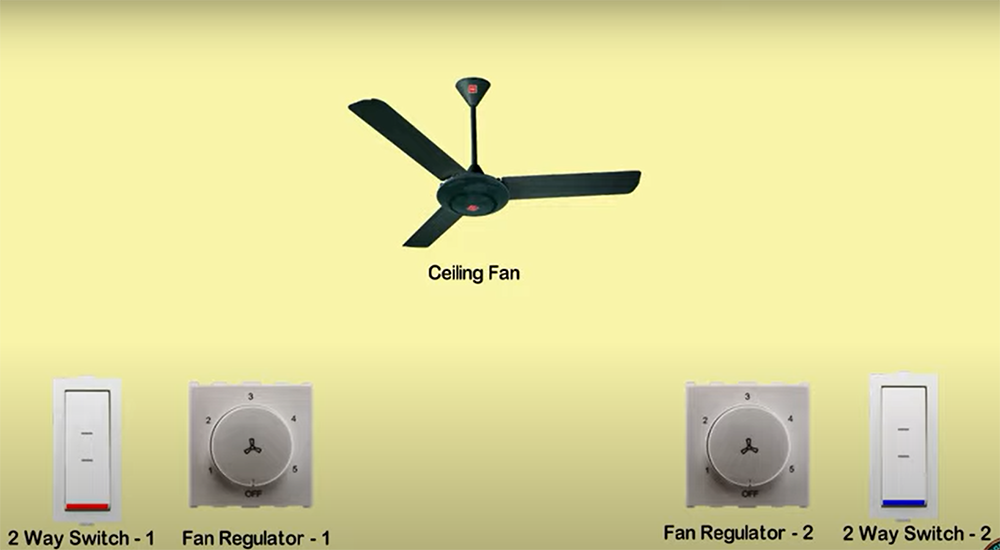If you’re looking to buy a new ceiling fan, one of the decisions you’ll have to make is what size of fan to get. You may be wondering how many ceiling fans you can put on a 20 amp circuit. In this blog post, we will answer that question and give you some tips on buying a new ceiling fan.
What is the difference between a 15 amp and a 20 amp circuit?
The main difference is that the 20 amp can handle more electricity. This means that a 20-amp circuit can power more appliances than a 15-amp circuit.
Moreover, a 20-amp circuit is often used for larger appliances such as air conditioners, while a 15-amp circuit is typically used for smaller appliances such as microwaves [1].
One more difference between these two types of circuits is that a 20-amp circuit has thicker wires than a 15-amp circuit. This is because thicker wires can handle more electricity without overheating.

How many ceiling fans are on a 20 amp circuit?
It is a common question that we get here. The answer, however, is not so cut and dry. There are a variety of factors that can impact.
- The first factor to consider is the wattage of the ceiling fan. Most standard ceiling fans are between 60 and 80 watts. This means that you can put up to 20 ceiling fans on a 20-amp circuit. However, if you have ceiling fans with a higher wattage, you may only be able to put fewer fans on the circuit.
- Another factor to consider is the type of ceiling fan you have. If you have a standard ceiling fan, it will likely use less power than a ceiling fan with lights or other features.
- The next factor is the efficiency of the ceiling fan. More efficient fans will use less power and therefore put less strain on the circuit. This means that you may be able to put more efficient ceiling fans on a 20-amp circuit than less efficient ones.
- Finally, the number of other devices on the circuit can also impact how many ceiling fans you can have. If there are other devices drawing power from the same circuit, it will reduce the amount of power available for the ceiling fans.
In general, you should be able to put about 20 standard ceiling fans on a 20-amp circuit. However, you should always consider other factors such as the wattage of the ceiling fan, the type of ceiling fan, and the efficiency of the ceiling fan when determining how many to put on a circuit.
How many outlets are on a 20 amp circuit?

A typical one can handle up to 2400 watts, which is enough for 12 standard outlets. If you have a higher wattage rating, you can have more outlets on your circuit.
However, it’s important to note that the actual number of outlets you can have on a 20 amp circuit is determined by the wattage rating of the devices you’re plugging into the outlets.
For example, if you have 12 standard outlets and each one is rated for 100 watts, then your total load would be 1200 watts, which is well within the capabilities of a 20 amp circuit.
However, if you have 12 outlets and each one is rated for 1000 watts, then your total load would be 12000 watts, which would trip the breaker.
Can two switches control one ceiling fan?
The simple answer is yes. However, there are a few things to consider when doing this.
The first is the amperage of the circuit that the fan is on. Most ceiling fans require at least a 15 amp circuit, so if your home has 20 amp circuits, you should switch.
The second thing to consider is the type of switches you are using. If you are using two single pole switches, then each switch will control the fan independently of the other. This means that if one switch is turned off, the other switch can still turn the fan on.
- However, if you are using two three-way switches, then the switches will be interconnected and both switches must be in the same position in order for the fan to be turned on or off.
The third thing to consider is the wiring of the switches. If you are unsure of how to wire the switches, it is best to consult with an electrician or your local hardware store.

Does a ceiling fan use more electricity than a box fan?
Yes! A ceiling fan uses more electricity than a box fan. There are a couple of reasons why this is true.
- First, ceiling fans have motors that are bigger and more powerful than the motors in box fans. These motors use more electricity to run.
- Second, ceiling fans have blades that are bigger and heavier than the blades in box fans. Moreover, ceiling fans typically have more blades than box fans. This means that they move more air, which requires more energy.
- Third, ceiling fans typically have higher speeds than box fans. This means that they use more electricity to run.
- Fourth, ceiling fans are often used in larger rooms than box fans. This means that they have to work harder to move the air around.
So, if you’re looking to save on your electricity bill, it’s best to use a box fan instead of a ceiling fan.
Can two circuits go on one breaker?
It is possible, but it is not recommended. There are some reasons for this.

One reason is that if there is a problem with one circuit, it can affect the other circuit as well. It can cause a fire hazard if not done correctly.
Another reason is that if you have multiple circuits on one breaker, and one circuit trips the breaker, then all the circuits will be without power until the breaker is reset.
This can create a fire hazard if the breaker is not properly rated for the number of circuits.
In addition, having multiple circuits on one breaker can cause the breaker to trip more frequently.
It is always best to consult with an electrician before making any changes to your electrical system.
Moreover, make sure that they are evenly distributed and do not overload the circuit.
Can a 20 amp breaker handle 240 volts?
Yes, a 20 amp breaker can handle 240 volts. However, it is not recommended to use a 20 amp breaker for a 240-volt circuit.
The reason for it is because the National Electrical Code (NEC) requires that a 20 amp circuit be protected by a 15 amp breaker.
If you need to use a 240-volt circuit, it is recommended that you use a 30 or 40 amp breaker.
Does a ceiling fan have to be wired to a switch?
No, a ceiling fan does not have to be wired to a switch. It can be connected directly to the power supply. However, if you want to be able to turn the fan on and off from a switch, you will need to wire it to a switch.
There is a way to wire a ceiling fan so that it can be controlled by two switches. This is called a three-way switch. A three-way switch is used to control a light from two different locations. For example, you could have a light switch at the top and bottom of a staircase.
You will need to use special wires when wiring a three-way switch. The wires will have to be connected to the correct terminals on the switch.
Moreover, you should consult a professional electrician to wire a three-way switch. This is because it can be tricky and dangerous to wire a three-way switch yourself.
Please remember to turn off the power before working on any electrical wiring.
How Many Ceiling Fans On a 20 Amp Circuit – Comparison Table
The table below presents a comparison of the number of ceiling fans that can be safely accommodated on a 20 Amp circuit for various fan wattages and typical amperage ratings.
| Ceiling Fan Wattage (W) | Typical Amperage (A) | Number of Fans on a 20 Amp Circuit |
|---|---|---|
| 60 | 0.5 | 40 |
| 75 | 0.6 | 33 |
| 100 | 0.8 | 25 |
| 150 | 1.2 | 16 |
| 200 | 1.7 | 11 |
| 250 | 2.1 | 9 |
The table provides a comparison of ceiling fan wattages and their corresponding typical amperage ratings, along with the number of fans that can be safely connected on a single 20 Amp circuit. It is essential to consider the amperage when determining how many fans can be installed on a circuit to avoid overloading it.
As shown in the table, a 20 Amp circuit can support a greater number of low-wattage fans with lower typical amperage. For instance, if each ceiling fan consumes 60 Watts and has a typical amperage of 0.5 Amps, you can connect up to 40 fans on the same circuit. On the other hand, for higher-wattage fans with greater typical amperage, the number of fans that can be connected decreases significantly. For instance, if each fan consumes 250 Watts and has a typical amperage of 2.1 Amps, only up to 9 fans can be safely connected to the 20 Amp circuit.
It is important to mention that this table assumes no other devices are connected to the circuit, and it is solely focused on the capacity for ceiling fans. Always consult a qualified electrician or refer to the manufacturer’s specifications for precise electrical load calculations before installing multiple fans on a circuit to ensure safety and proper functioning.
Read our helpful guides to upgrade your knowledge in electronics:
- How to Build a Prototype Electronic Circuit?
- What is Star Delta Starter Circuit?
- Difference Between an Open Circuit and a Closed Circuit
FAQ
Does a ceiling fan need a dedicated circuit?
No, a ceiling fan does not need a dedicated circuit. However, if the fan is on its own circuit, it will not share power with other appliances and will not trip the breaker when in use.
How many Amps does a 52 ceiling fan use?
A 52 ceiling fan uses about 0.7 Amps. This is a relatively low amount of power, which means that you can have several ceiling fans on one circuit without overloading it.
Is it safe to put a ceiling fan on a 15 Amp circuit?
Yes, it is safe to put a ceiling fan on a 15 Amp circuit. However, you should consider upgrading the circuit to 20 Amps if you plan on running multiple appliances on the same circuit.
Upgrading to a 20 Amp circuit will give you more flexibility and peace of mind, knowing that your ceiling fan will not trip the breaker when in use.
Can I put a ceiling fan and light on the same circuit?
Yes, you can put a ceiling fan and light on the same circuit. However, if the combined load of the two fixtures exceeds the ampacity of the circuit, then you will need to install a second circuit for both fixtures.
Do ceiling fans draw a lot of electricity?
Ceiling fans typically do not draw a lot of electricity. However, if you have a room with multiple ceiling fans, consider putting them on their own circuit so that they can be used simultaneously without overloading the circuit.
What is the maximum number of ceiling fans I can put on a 20 Amp circuit?
The maximum number of ceiling fans you can put on a 20 Amp circuit depends on the current draw of each fan and the total current capacity of the circuit. Most standard residential ceiling fans typically draw around 0.5 to 2 Amps. To calculate the number of fans, divide the total available current (20 Amps) by the current draw of each fan.
Can I use a 20 Amp circuit for multiple ceiling fans with lights?
Yes, you can use a 20 Amp circuit for multiple ceiling fans with lights, as long as the total current draw of all the fans and lights combined does not exceed the circuit’s capacity. Consider the current draw of both the fan and light kits when calculating the total load on the circuit.
How do I determine the current draw of my ceiling fan?
To determine the current draw of your ceiling fan, check the product’s specifications or the label on the fan itself. The current draw is typically measured in Amperes (A) and can vary depending on the fan’s size, motor, and any additional features like lights.
What should I do if the total current draw exceeds the 20 Amp circuit’s capacity?
If the total current draw of the ceiling fans and other devices on the circuit exceeds 20 Amps, it’s essential to redistribute the load. You can either reduce the number of fans or lights on the circuit or consider installing a separate circuit dedicated to the ceiling fans.
Can I use a 20 Amp circuit for high-powered ceiling fans or industrial fans?
No, it is not recommended to use a 20 Amp circuit for high-powered ceiling fans or industrial fans. These fans typically draw more current than standard residential fans and could overload the circuit. For high-powered fans, consider using a dedicated circuit or consult an electrician to ensure the proper circuit capacity.
Useful Video: Ceiling Fan Placement, Specifications & Recommendations
Final Thoughts
While you can technically put as many ceiling fans as you want on a 20 amp circuit, it’s not recommended. Not only will this overload the circuit, but it can also pose a fire hazard. It’s always better to err on the side of caution and stick to four fans or less.
If you’re not sure whether your circuit can handle the load, be sure to consult with a professional electrician. They’ll be able to help you determine the best course of action for your specific situation.
I hope this article helped clear things up for you. If you have any further questions, feel free to leave a comment below and I’ll do my best to answer them.
Thanks for reading! Share this post with your friends and family if you found it useful.
Do you have any experience with wiring ceiling fans? We’d love to hear about it in the comments below!
Have a great day!
References:
- https://bikehike.org/how-many-ceiling-fans-on-a-20-amp-circuit-1/














I believe that a ceiling fan can use anywhere from 1 to 6 amps, depending on the model and size of the fan. So, on a 20 amp circuit, you could have between 2 and 12 ceiling fans. Obviously, this would depend on the size of your home and how many ceiling fans you want to install. But in my case, I would need at least 4 ceiling fans to cool my home and it didn’t cause me any issues whatsoever.